Each dog, depending on its breed, age, individual characteristics and environmental factors, has its own nutritional needs. And each owner has a choice - to make a dog’s diet on their own or to resort to ready-made feeds.
Of course, feeding the dog with ready-made food greatly simplifies the process of keeping the animal, especially large, but not all of them will be not only safe, but also beneficial to the health of your pet. Let us consider in more detail the features of the formulations and the rules for choosing food for large dogs.
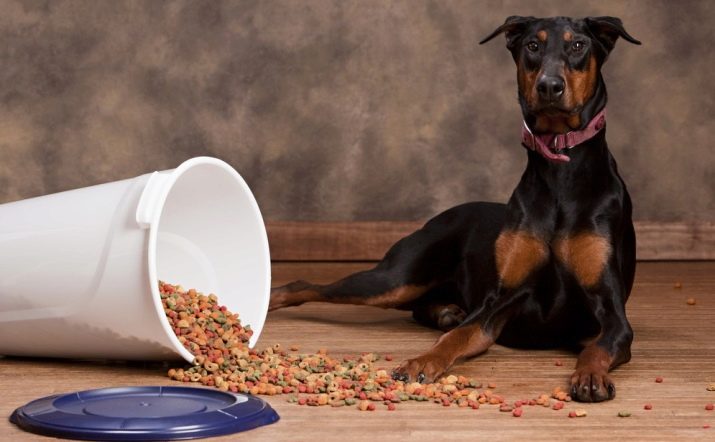
Structure
Each owner should know that when choosing food for your pet, you must first pay attention to the composition. For example, when you choose food for puppies of large breeds, you should first look at the amount of protein in it, since it is one of the main building components of their body. Moreover for dogs, meat protein is most desirable, as it is most physiological for the digestion of your little pet. It is for this reason that it is important to maintain a rational ratio between the animal and plant components, and within the animal protein fraction between meat and protein of a different origin (for example, milk or egg).
It is also important to determine the presence of fat in the composition, because fatty acids are an excellent energy depot for their subsequent use in the process of dog growth. Fat is involved in the formation of adipose tissue, which acts as a heat insulator, mechanical protection of certain parts of the body.
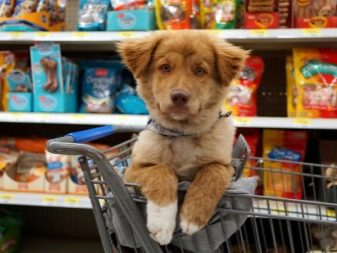

Moreover, for dogs, the ratio of vegetable and animal fats is very important, since its different types have different properties, for example, plant ones have antioxidant properties. But you should know that an abundance of fat can lead to obesity.
Carbohydrates are the main source of fuel for the current physiological processes of your pet's body. They can be divided into “fast” and “slow”. Slow are more beneficial for the dog, as they do not stimulate fat deposition in the body., longer provide the energy balance of the body and give persistent saturation. The abundance of light, fast carbohydrates, as well as the abundance of fat, leads to a rapid gain in body weight by the dog.
Micronutrients, such as vitamins and minerals, provide the dog with the ability to support enzymatic processes, help in the formation of the connective tissue structure of the body and the proper functioning of its systems.

All of the above is true both for puppies and, to some extent, for adult dogs of large breeds. In adults, the need for calories per unit mass, in protein and micronutrients is less, since the formation of their body as a whole is completed. Therefore, the composition of their food ceases to be such a delicate topic and allows more liberties.
Kinds
Dog food is divided into economy, premium and super-premium classes. Outside this classification are the so-called types of finished food - holistic.
In economy-class nutrition, the content of natural meat is practically reduced to zero, its main component is meat offal. In premium and super-premium feeds, the content of natural meat is much higher, and the feed is holistic and consists entirely of organic and healthy components.
In addition, the compositions can be classified according to several criteria - grain-free and with grain protein, containing meat and not containing meat protein, with flavorings, preservatives and without them. It should also be noted that the finished food is divided into dry and canned (wet) varieties.
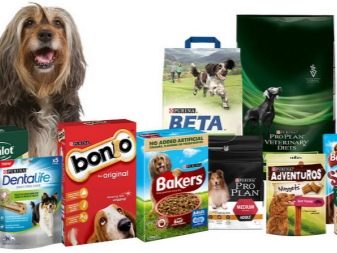
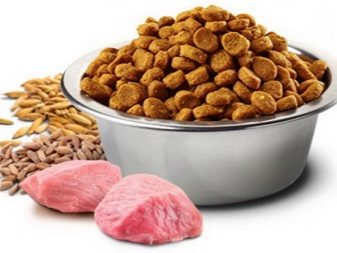
Brand Overview
In order to choose a suitable ready-made diet for your large pet, you need to take care of the quality of this food, which manufacturers usually vouch for. First, pay attention to the economy-class feed.
- Dog Chow. As a part of this raw material, the main source of protein is turkey meat, it contains products from cereals, soy, as well as preservatives and flavorings. From the advantages of the product can be identified low cost, relatively high prevalence. Of the minuses - an inadequate composition, containing mainly by-products of turkey, cereals, soy and only 30% protein, so this food is extremely unphysiological, especially for puppies.
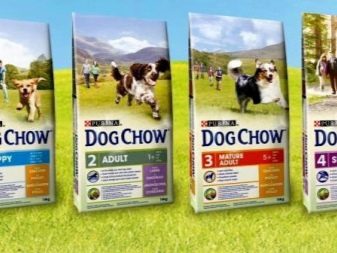

For this reason, veterinarians speak quite negatively about this type of food and about the brand as a whole.
- Our Brand food for large breeds. This feed includes chicken, corn, sunflower and beets. This food is also mineralized, but it contains only a quarter of the protein, and the composition, as in the previous case, contains many by-products, for example, flour from chicken parts. The advantage of this food is its low price. And the disadvantages are just as dictated by the characteristics of the composition - the likelihood of developing an allergic reaction to corn gluten, the unphysiological composition of the offal can disrupt the puppy's growth rate.
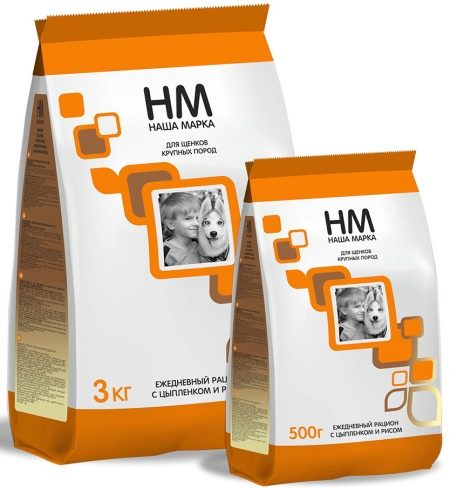
- Pedigree for puppies of large breeds. The main source of protein, as in the past case, is an offal of chicken and other types of meat. A carbohydrate donor is a mixture of convenience foods, rice and cereals, as well as beet pulp. The fats in this feed are of animal origin. This food has the same advantages inherent in this price category - absolute recognition and prevalence, affordable price. Cons of this food is an unbalanced composition that threatens with impaired growth and development of the puppy.
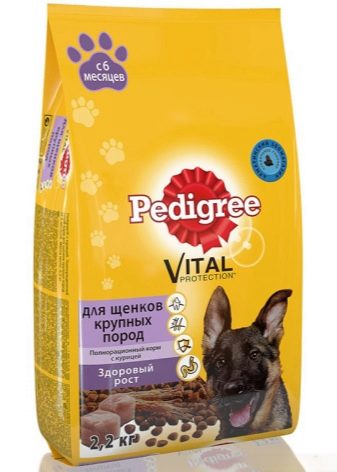
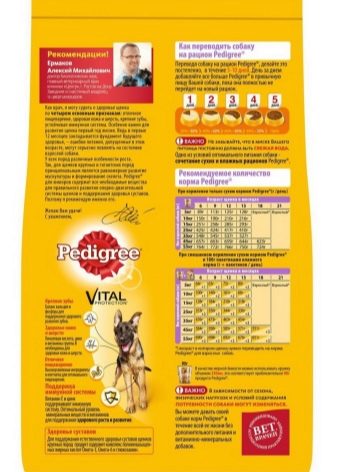
Next, we pay attention to premium feed.
- Royal Canin. This food contains dried poultry, not an offal. Corn is used as a source of carbohydrates. Advantages of feed - relative popularity, average price, the presence of whole meat in the composition. Cons - half of the protein is of vegetable origin, not the whole composition is thoroughly laid out, which does not allow us to fully assess the potential of this food.
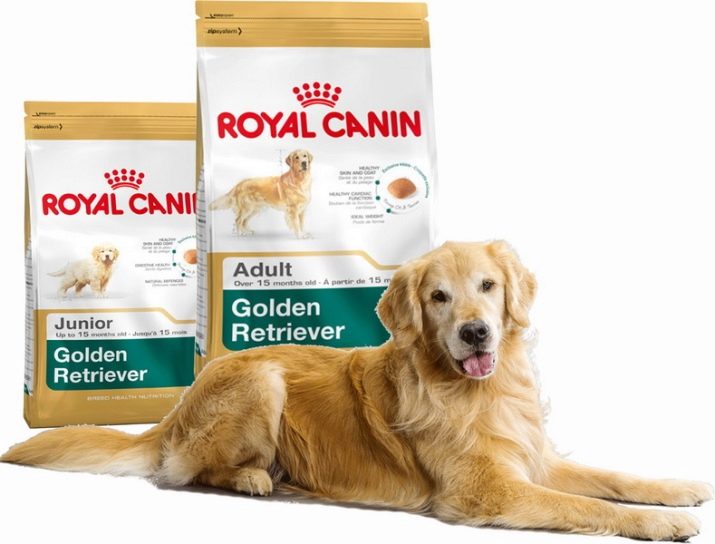
Veterinarians are ambiguous about this brand, on the one hand, highlighting the presence of whole meat in the composition, and on the other, noting the ambiguity of the presentation of its components.
- Hill's Science plan. In this diet, as in the previous one, the main formative component is corn. Chicken in the form of flour acts as a meat component, there are additives in the form of animal fats, as well as a hydrolyzate of unspecified protein - it is impossible to say animal or vegetable. The reviews of veterinarians are similar to the previous feed, since the composition is not entirely clear and it is impossible to assess the harm or benefit of this feed to the dog’s health.

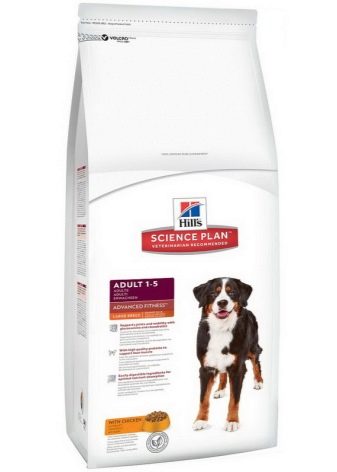
- Pronature. Sources of protein in feed are chicken and corn gluten. The protein content in it is slightly less than 40%. The carbohydrate component is presented in the form of rice and cornmeal; mineral enrichment is present. In the list of advantages of this feed, a noticeable plus is the price, relatively rich in protein composition, mineralization and saturation with micronutrients. This food is not without its drawbacks - the undisclosed distribution of proteins by origin, the product is relatively difficult to find in stores, since it is not very widespread.
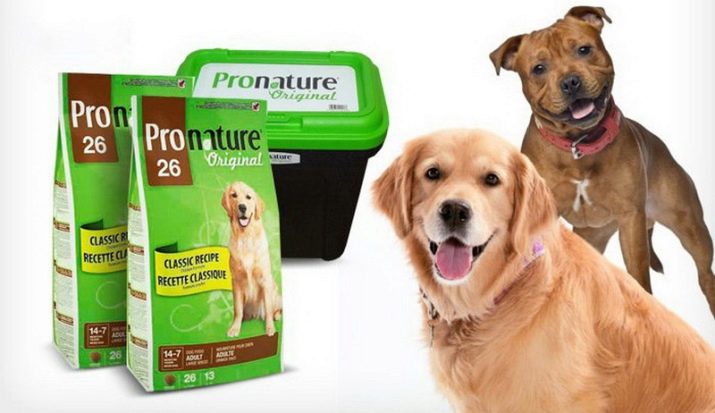
Veterinarians favor this food, noting its balanced composition of minerals and vitamins, the optimal proportion of fats and a large amount of protein, but allergic reactions are also possible due to the presence of corn gluten.
- Probalance. This food contains up to 30% of dry poultry meat. In addition, this diet includes cereals (rice, barley, oats), chicken fat and vegetable oils, such as flaxseed. In addition, the composition is abundantly mineralized and fortified, but it contains not entirely safe additives (E321). Thus, the advantages of the feed can be attributed a very compromise price with good quality of execution, because almost a third of the feed consists of whole, although dry, meat, and carbohydrates in the feed are not in the form of offal. Disadvantages of the product - it contains the above-mentioned ambiguous additive, the safety of which is not fully understood. In general, this food is an excellent option in terms of price and quality.
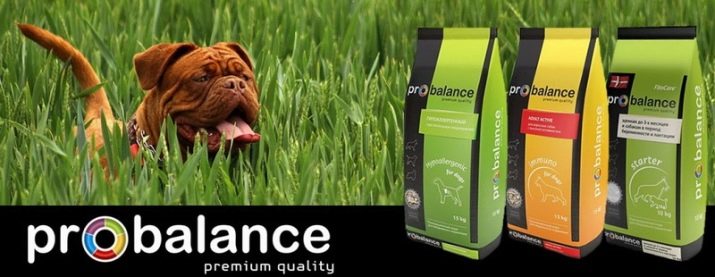
- ProPlan for puppies of large breeds. It contains 17% of chicken protein, which does not allow us to unequivocally state that this is only meat. It also contains corn, wheat, animal proteins, beetroot components and other plant and animal ingredients. Moreover, beets and some plant components are presented as offal. The composition does not explain what kind of “flavoring additive” is used in the feed, nor does the complex of incoming vitamins be specified. Thus, the advantages of this feed are recognition, affordability, price; Cons - it has little protein, the presence of offal, undisclosed components.
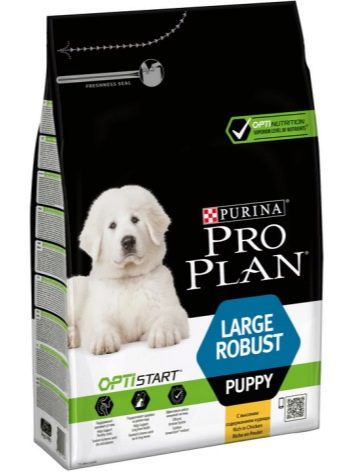
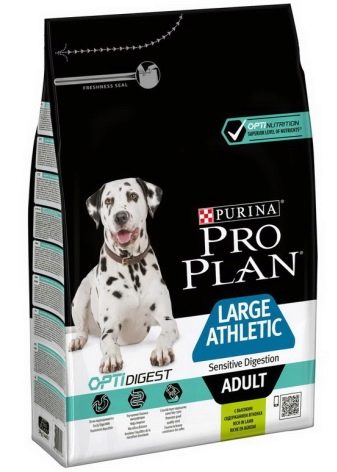
Therefore, you cannot accurately correlate the benefits and harms of this food for your pet.
Rating of feeds of super-premium class, as well as holistic class diets.
- Acana This diet contains almost entirely natural ingredients. The source of animal protein in it is chicken meat, moreover, both fresh and dry, separated from the bones. There is also turkey meat and other meat components, the sum of which gives the meat share in the product above 62%. Also present are eggs, beans and many other natural plant components. It is important to consider that during cooking the meat is reduced, so the proportion of protein in the final product is declared at 33%, and the manufacturer maintains this bar.There are no artificial ingredients in this feed, and the available natural product is very high quality. The composition of the feed is balanced, so it is very useful for the dog. Pluses - product quality noted above, balanced composition; cons - the price, also it can not always be found in the supermarket near the house.
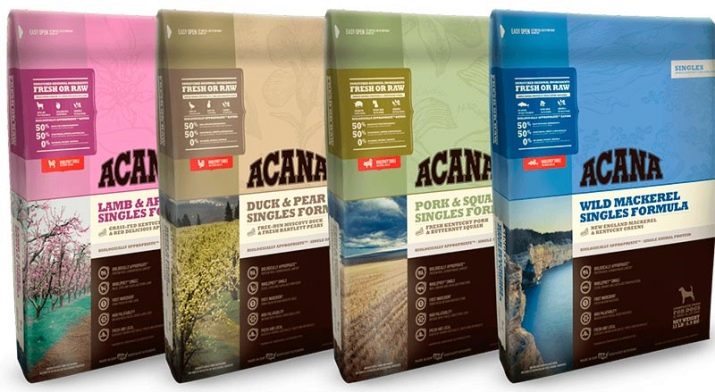
- Now. This feed contains meat of turkey, salmon, egg white. The meat parts of the product are presented in the form of fillets, eggs - whole. This diet is grainless, and the main source of carbohydrates in it is potatoes. In addition, in the composition, as in the previous version, all the ingredients are natural, but their percentage is not indicated, so it is difficult to say how much meat is contained in the feed. Total protein is just under thirty percent. The advantages of this feed are the availability of natural products, their relatively physiological layout, and among the significant disadvantages there will be an understated composition and a relatively high price.
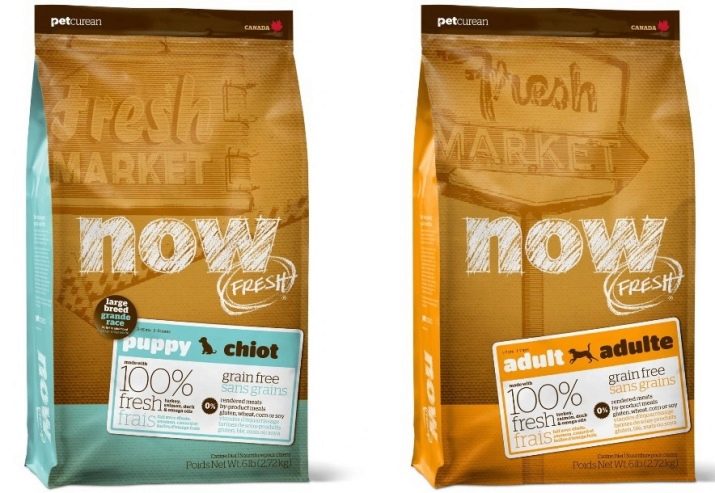
- Farmina N&D. As part of this feed, the main donors of animal protein are fresh and dry boneless chicken meat, contain egg components, chicken fat and fish (its meat, fat). The food includes dry vegetables, fruits, vitamins and minerals. There are natural flavors. The main source of carbohydrates is potatoes, and plant fibers - peas. The advantages of this feed are the natural origin of the ingredients, the balanced composition; cons - price, it is also not always possible to find this food nearby.
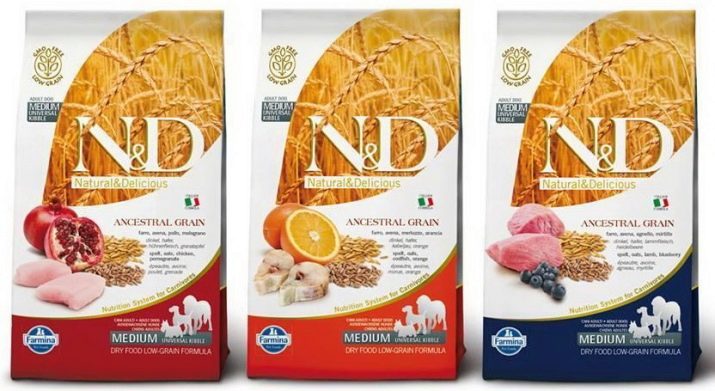
- Orijen. This diet contains up to 20% fresh boneless chicken meat, up to 15% dry chicken meat and about 10% more animal components, which makes it a very saturated protein. The carbohydrate component is presented in the form of sweet potato, peas and lentils. Plus of this diet is usefulness, but such an abundance of protein is controversial (38% of protein in the final product), minus is the price.
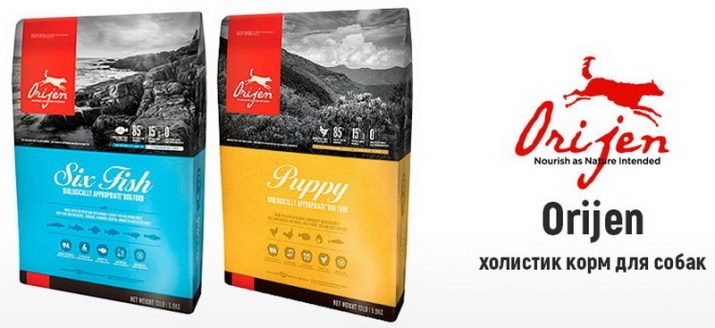
Criterias of choice
The choice of food for active and large dogs should be taken with utmost responsibility and attention. Therefore, the choice of "dishes" can be guided by the following principles.
- If possible, exclude all economy-class feeds from the sample, since they often consist of offal, their formulation is imperfect, and the composition is not in balance, which violates the puppy's growth rate or the physiological processes of the dog at any age.
- If the price is not a limiting factor for you, it is advisable to turn your attention to feeds with a completely natural composition, for example, holivics or a super-premium group, as such feeds will have the best assimilation, causing the least discomfort to the digestion of the dog.
- The feed you are interested in should contain notes that this food is intended for large dogs, and if you still have a puppy, then other relevant notes. In addition, the portion distribution for an adult dog or the consumption rate for puppies of different ages should be indicated on the back of the package.
- Always read the composition carefully. In the feed there should not be flavor modifiers, flavorings, preservatives. When studying the composition, pay attention to whether the product consists of whole foods or flour. Also look at the distribution of protein, fats and carbohydrates in the feed, vegetable and animal proteins, if there are grain components. If your dog has an active, mobile disposition, you should focus on determining the amount of protein and carbohydrates.
- It is very important to pay attention to the calorie content of the feed, the lower it is - the better your pet’s health status will be in the future.
- Be sure to read the reviews, ask the familiar breeders - perhaps they have advice for you regarding the choice of feed.
- After the purchase, try a small portion on your dog. If she likes the food, you can switch to this diet completely; if she doesn’t like this product, she will have to look for another one.

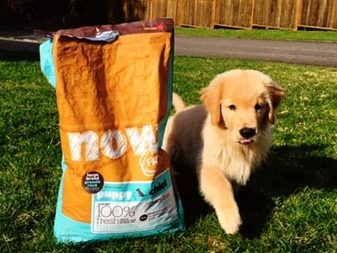
Power Features
Large dogs have their own eating habits.For example, large dogs have a risk of certain diseases, for example, gout, and an increasing body weight leads to an increase in the load on the supporting joints, which provokes their chronic damage.

In order to prevent these phenomena, it is required to feed the dog strictly according to the regimen, at a specific time and with the appropriate amount of food. It is advisable to give preference to feeds with lean meat in the composition and a large number of useful vegetable components.
See how to choose dry dog food in the next video.








































